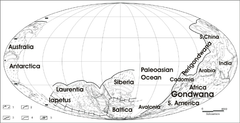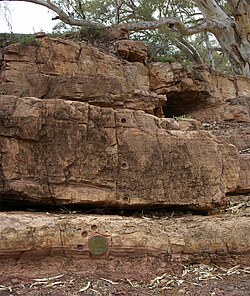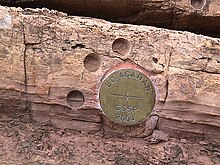Ediacaran
| Ediacaran Period 635–541 million years ago | |

Plate tectonics of Earth in Ediacaran-Cambrian boundary (544 Ma), shortly after the breakup of Pannotia. | |
| Mean atmospheric O 2 content over period duration |
c. 8 vol % (40 % of modern level) |
| Mean atmospheric CO 2 content over period duration |
c. 4500 ppm (16 times pre-industrial level) |
| Mean surface temperature over period duration | c. 17 °C (3 °C above modern level) |
Events of the Ediacaran Period -640 — – -630 — – -620 — – -610 — – -600 — – -590 — – -580 — – -570 — – -560 — – -550 — – -540 — – Major Glacial period Stratigraphic scale of the ICS subdivisions and Precambrian/Cambrian boundary. | |
The Ediacaran Period ( /iː.diːˈæk.ə.rən/ ee-dee-AK-ə-rən)[1] is a geological period that spans 94 million years from the end of the Cryogenian Period 635 million years ago (Mya), to the beginning of the Cambrian Period 541 Mya. It marks the end of the Proterozoic Eon, and the beginning of the Phanerozoic Eon. It is named after the Ediacara Hills of South Australia.
The Ediacaran Period's status as an official geological period was ratified in 2004 by the International Union of Geological Sciences (IUGS), making it the first new geological period declared in 120 years.[2][3][4] Although the period takes its name from the Ediacara Hills where geologist Reg Sprigg first discovered fossils of the eponymous Ediacara biota in 1946,[5] the type section is located in the bed of the Enorama Creek[6] within Brachina Gorge[7] in the Flinders Ranges of South Australia, at 31°19′53.8″S 138°38′0.1″E / 31.331611°S 138.633361°E.
Ediacaran and Vendian[edit]
The Ediacaran Period overlaps, but is shorter than the Vendian Period, a name that was earlier, in 1952, proposed by Russian geologist and paleontologist Boris Sokolov. The Vendian concept was formed stratigraphically top-down, and the lower boundary of the Cambrian became the upper boundary of the Vendian.[8][9]
Paleontological substantiation of this boundary was worked out separately for the siliciclastic basin (base of the Baltic Stage of the Eastern European Platform[10]) and for the carbonate basin (base of the Tommotian stage of the Siberian Platform).[11] The lower boundary of the Vendian was suggested to be defined at the base of the Varanger (Laplandian) tillites.[9][12]
The Vendian in its type area consists of large subdivisions such as Laplandian, Redkino, Kotlin and Rovno regional stages with the globally traceable subdivisions and their boundaries, including its lower one.
The Redkino, Kotlin and Rovno regional stages have been substantiated in the type area of the Vendian on the basis of the abundant organic-walled microfossils, megascopic algae, metazoan body fossils and ichnofossils.[9][13]
The lower boundary of the Vendian could have a biostratigraphic substantiation as well taking into consideration the worldwide occurrence of the Pertatataka assemblage of giant acanthomorph acritarchs.[12]
Upper and lower boundaries[edit]

The Ediacaran Period (c. 635–541 Mya) represents the time from the end of global Marinoan glaciation to the first appearance worldwide of somewhat complicated trace fossils (Treptichnus pedum (Seilacher, 1955)).[2]
Although the Ediacaran Period does contain soft-bodied fossils, it is unusual in comparison to later periods because its beginning is not defined by a change in the fossil record. Rather, the beginning is defined at the base of a chemically distinctive carbonate layer that is referred to as a "cap carbonate", because it caps glacial deposits.
This bed is characterized by an unusual depletion of 13C that indicates a sudden climatic change at the end of the Marinoan ice age. The lower boundary global boundary stratotype section (GSSP) of the Ediacaran is at the base of the cap carbonate (Nuccaleena Formation), immediately above the Elatina diamictite in the Enorama Creek section, Brachina Gorge, Flinders Ranges, South Australia.
The GSSP of the upper boundary of the Ediacaran is the lower boundary of the Cambrian on the SE coast of Newfoundland approved by the International Commission on Stratigraphy as a preferred alternative to the base of the Tommotian Stage in Siberia which was selected on the basis of the ichnofossil Treptichnus pedum (Seilacher, 1955). In the history of stratigraphy it was the first case of usage of bioturbations for the System boundary definition.
Nevertheless, the definitions of the lower and upper boundaries of the Ediacaran on the basis of chemostratigraphy and ichnofossils are disputable.[12][14]
Cap carbonates generally have a restricted geographic distribution (due to specific conditions of their precipitation)[vague] and usually siliciclastic sediments laterally replace the cap carbonates in a rather short distance but cap carbonates do not occur above every tillite elsewhere[clarification needed] in the world.
The C-isotope chemostratigraphic characteristics obtained for contemporaneous cap carbonates in different parts of the world may be variable in a wide range owing to different degrees of secondary alteration of carbonates, dissimilar criteria used for selection of the least altered samples, and, as far as the C-isotope data are concerned, due to primary lateral variations of δ l3Ccarb in the upper layer of the ocean.[12][15]
Furthermore, Oman presents in its stratigraphic record a large negative carbon isotope excursion, within the Shuram[16] Formation that is clearly away from any glacial evidence[17] strongly questioning systematic association of negative δ l3Ccarb excursion and glacial events.[18] Also, the Shuram excursion is prolonged and is estimated to last for ~9.0 Myrs.[19]
As to the Treptichnus pedum, a reference ichnofossil for the lower boundary of the Cambrian, its usage for the stratigraphic detection of this boundary is always risky, because of the occurrence of very similar trace fossils belonging to the Treptichnids group well below the level of T. pedum in Namibia, Spain and Newfoundland, and possibly, in the western United States. The stratigraphic range of T. pedum overlaps the range of the Ediacaran fossils in Namibia, and probably in Spain.[12][20]
Subdivisions[edit]
The Ediacaran period is not yet formally subdivided, but a proposed scheme[21] recognises an Upper Ediacaran whose base corresponds with the Gaskiers glaciation, a Terminal Ediacaran Stage starting around 550 million years ago, a preceding stage beginning around 557 Ma with the earliest widespread Ediacaran biota fossils; two proposed schemes differ on whether the lower strata should be divided into an Early and Middle Ediacaran or not, because it's not clear whether the Shuram excursion (which would divide the Early and Middle) is a separate event from the Gaskiers, or whether the two events are correlated.
Absolute dating[edit]
The dating of the rock type section of the Ediacaran Period in South Australia has proven uncertain. Therefore, the age range of 635 to 542 million years is based on correlations to other countries where dating has been possible. The base age of approximately 635 million years is based on U–Pb (uranium–lead) isochron dating from Namibia[22] and China.[23]
Applying this age to the base of the Ediacaran assumes that cap carbonates are laid down synchronously around the world and that the correct cap carbonate layers have been selected in such diverse locales as Australian and Namibia. This is controversial because an age of about 580 million years has been obtained for glacial rocks in Tasmania which some scientists tentatively assign to those just beneath the Ediacaran rocks of the Flinders Ranges.[24] The age of the top is the same as the widely recognised age for the base of the Cambrian Period[25] 542± 0.3 Mya,[26] producing a misalignment, as the end of the Edicarian Period should mark the start of the Cambrian Period.
Biota[edit]
The fossil record from the Ediacaran Period is sparse, as more easily fossilized hard-shelled animals had yet to evolve. The Ediacaran biota include the oldest definite multicellular organisms (with specialized tissues), the most common types of which resemble segmented worms, fronds, disks, or immobile bags.
Some hard-shelled agglutinated foraminifera are known from latest Ediacaran sediments of western Siberia.[27]
Ediacara biota bear little resemblance to modern lifeforms, and their relationship even with the immediately following lifeforms of the Cambrian explosion is rather difficult to interpret. More than 100 genera have been described, and well known forms include Arkarua, Charnia, Dickinsonia, Ediacaria, Marywadea, Cephalonega, Pteridinium, and Yorgia.
There is evidence for a mass extinction during this period from early animals changing the environment.[28]
Astronomical factors[edit]
The relative proximity of the Moon at this time meant that tides were stronger and more rapid than they are now. The day was 21.9±0.4 hours, and there were 13.1±0.1 synodic months/year and 400±7 solar days/year.[29]
Documentaries[edit]
A few English language documentaries have featured the Ediacaran period and biota:
- The Time Traveller's Guide To Australia (2012, ABC Network Australia; Part 1 of 4).
- The Geological History of Canada, as part of The Nature of Things series, CBC-SRC; 2011; Eastern Canada.
- The first episode of a BBC documentary titled Life on Earth, with David Attenborough as narrator.
- Another documentary narrated by David Attenborough titled First Life featuring Charnia, Dickinsonia, Spriggina, Funisia, and Kimberella animated in CGI.
- In our time - Edicara Biota, BBC, 9 July 2009
See also[edit]
- List of fossil sites – A table of worldwide localities notable for the presence of fossils (with link directory)
- Avalon explosion
- End-Ediacaran extinction
References[edit]
- ^ "Ediacaran". Dictionary.com Unabridged. Random House.
- ^ a b A. Knoll, M. Walter, G. Narbonne, and N. Christie-Blick (2004) "The Ediacaran Period: A New Addition to the Geologic Time Scale." Submitted on Behalf of the Terminal Proterozoic Subcommission of the International Commission on Stratigraphy.
- ^ Knoll, A. H.; Walter, MR; Narbonne, G. M; Christie-Blick, N (30 July 2004). "A new period for the geologic time scale" (PDF). Science. 305 (5684): 621–622. doi:10.1126/science.1098803. PMID 15286353.
- ^ Knoll, A. H.; Walter, M. R.; Narbonne, G. M. & Christie-Blick, N. (March 2006). "The Ediacaran Period: A new addition to the geologic time scale" (PDF). Lethaia. 39: 13–30. doi:10.1080/00241160500409223. Archived from the original (PDF) on 21 February 2007.
- ^ Sprigg, Reg. C. (1947). "Early Cambrian (?) jellyfishes from the Flinders Ranges, South Australia". Transactions of the Royal Society of South Australia. 71 (2): 212–224.
- ^ "Geological time gets a new period: Geologists have added a new period to their official calendar of Earth's history—the first in 120 years". London: BBC. 17 May 2004. Accessed 27 December 2010.
- ^ South Australian Museum Newsletter April 2005 Archived 17 February 2011 at the Wayback Machine Accessed 9 August 2010.
- ^ B. M. Sokolov (1952). "On the age of the old sedimentary cover of the Russian Platform". Izvestiya Akademii Nauk SSSR, Seriya Eologicheskaya. 5: 21–31.
- ^ a b c Sokolov, B.S. (1997). "Essays on the Advent of the Vendian System." 153 pp. KMK Scientific Press, Moscow. (in Russian)
- ^ Sokolov B. S. (1965) "Abstracts of All-Union Symposium on Paleontology of the Precambrian and Early Cambrian." Nauka, Novosibirsk.
- ^ Rozanov, A.Y.; Missarzhevskij, V.V.; Volkova, N.A.; Voronova, L.G.; Krylov, I.N.; Keller, B.M.; Korolyuk, I.K.; Lendzion, K.; Michniak, R.; Pykhova, N.G. & Sidorov, A.D. (1969). "The Tommotian Stage and the problem of the lower boundary of the Cambrian". Trudy Geologičeskogo Instituta AN SSSR. 206: 1–380.
- ^ a b c d e M. A. Fedonkin; B. S. Sokolov; M. A. Semikhatov; N. M. Chumakov (2007). "Vendian versus Ediacaran: priorities, contents, prospectives". Archived from the original on 4 October 2011. In: "The Rise and Fall of the Vendian (Ediacaran) Biota" (PDF). Origin of the Modern Biosphere. Transactions of the International Conference on the IGCP Project 493n Moscow: GEOS. 20–31 August 2007. Archived from the original (PDF) on 22 November 2012. (82mb)
- ^ Khomentovsky, V. V. (2008). "The Yudomian of Siberia, Vendian and Ediacaran systems of the International stratigraphic scale". Stratigraphy and Geological Correlation. 16 (6): 581–598. Bibcode:2008SGC....16..581K. doi:10.1134/S0869593808060014.
- ^ Comments By B. S. Sokolov, M. A. Semikhatov, And M. A. Fedonkin. (2004) Appendix 2 in: "The Ediacaran Period: A New Addition to the Geologic Time Scale." Submitted on Behalf of the Terminal Proterozoic Subcommission of the International Commission on Stratigraphy. pp. 32–34
- ^ Bristow, T. F.; Kennedy, M. J. (2008). "Carbon isotope excursions and the oxidant budget of the Ediacaran atmosphere and ocean" (PDF). Geology. 36 (11): 863–866. Bibcode:2008Geo....36..863B. doi:10.1130/G24968A.1. Retrieved 5 May 2007.
- ^ Le Guerroué, E.; Allen, P. A.; Cozzi, A. (2006). "Chemostratigraphic and sedimentological framework of the largest negative carbon isotopic excursion in Earth history: The Neoproterozoic Shuram Formation (Nafun Group, Oman)". Precambrian Research. 146 (1–2): 68–92. Bibcode:2006PreR..146...68L. doi:10.1016/j.precamres.2006.01.007.
- ^ Le Guerroué, E.; Allen, P. A.; Cozzi, A.; Etienne, J. L.; Fanning, C. M. (2006). "50 Myr recovery from the largest negative δ13C excursion in the Ediacaran ocean". Terra Nova. 18 (2): 147–153. Bibcode:2006TeNov..18..147L. doi:10.1111/j.1365-3121.2006.00674.x. Archived from the original on 5 January 2013.
- ^ Le Guerroué, E.; Allen, P. A.; Cozzi, A. (2006). "Parasequence development in the Ediacaran Shuram Formation (Nafun Group, Oman): primary origin stratigraphic test of negative carbon isotopic ratios". Basin Research. 18 (2): 205–220. Bibcode:2006BasR...18..205L. doi:10.1111/j.1365-2117.2006.00292.x. Archived from the original on 5 January 2013.
- ^ Gong, Zheng; Kodama, Kenneth; Li, Yong-Xiang (2017). "Rock magnetic cyclostratigraphy of the Doushantuo Formation, South China and its implications for the duration of the Shuram carbon isotope excursion". Precambrian Research. 289: 62–74. Bibcode:2017PreR..289...62G. doi:10.1016/j.precamres.2016.12.002.
- ^ A. Ragozina, D. Dorjnamjaa, A. Krayushkin, E. Serezhnikova (2008). "Treptichnus pedum and the Vendian-Cambrian boundary". 33 Intern. Geol. Congr. August 6–14, 2008, Oslo, Norway. Abstracts. Section HPF 07 Rise and fall of the Ediacaran (Vendian) biota. P. 183.
- ^ Xiao, Shuhai; Narbonne, Guy M.; Zhou, Chuanming; Laflamme, Marc; Grazhdankin, Dmitriy V.; Moczydlowska-Vidal, Malgorzata; Cui, Huan (2016). "Towards an Ediacaran Time Scale: Problems, Protocols, and Prospects" (PDF). Episodes. 39 (4): 540555. doi:10.18814/epiiugs/2016/v39i4/103886. Archived from the original (PDF) on 20 August 2017. Retrieved 21 June 2017.
- ^ Hoffmann, K.H.; Condon, D.J.; Bowring, S.A.; Crowley, J.L. (1 September 2004). "U-Pb zircon date from the Neoproterozoic Ghaub Formation, Namibia: Constraints on Marinoan glaciation". Geology. 32 (9): 817–820. Bibcode:2004Geo....32..817H. doi:10.1130/G20519.1.
- ^ Condon, D.; Zhu, M.; Bowring, S.; Wang, W.; Yang, A. & Jin, Y. (1 April 2005). "U-Pb Ages from the Neoproterozoic Doushantuo Formation, China". Science. 308 (5718): 95–98. Bibcode:2005Sci...308...95C. doi:10.1126/science.1107765. PMID 15731406.
- ^ Calver, C.R.; Black, Lance P.; Everard, John L.; Seymour, David B. (1 October 2004). "U-Pb zircon age constraints on late Neoproterozoic glaciation in Tasmania". Geology. 32 (10): 893–896. Bibcode:2004Geo....32..893C. doi:10.1130/G20713.1.
- ^ Ogg, J. G. (2004). "Status of Divisions of the International Geologic Time Scale" (PDF). Lethaia. 37 (2): 183–199. doi:10.1080/00241160410006492. Retrieved 5 May 2007.
- ^ Amthor, J. E.; Grotzinger, John P.; Schröder, Stefan; Bowring, Samuel A.; Ramezani, Jahandar; Martin, Mark W.; Matter, Albert (2003). "Extinction of Cloudina and Namacalathus at the Precambrian-Cambrian boundary in Oman". Geology. 31 (5): 431–434. Bibcode:2003Geo....31..431A. doi:10.1130/0091-7613(2003)031<0431:EOCANA>2.0.CO;2.
- ^ Kontorovich, A. E.; Varlamov, A. I.; Grazhdankin, D. V.; Karlova, G. A.; Klets, A. G.; Kontorovich, V. A.; Saraev, S. V.; Terleev, A. A.; Belyaev, S. Yu.; Varaksina, I. V.; Efimov, A. S. (1 December 2008). "A section of Vendian in the east of West Siberian Plate (based on data from the Borehole Vostok 3)". Russian Geology and Geophysics. 49 (12): 932–939. doi:10.1016/j.rgg.2008.06.012. ISSN 1068-7971.
- ^ https://www.sciencedaily.com/releases/2015/09/150902123456.htm Science Daily
- ^ Williams, George E. (2000). "Geological constraints on the Precambrian history of Earth's rotation and the Moon's orbit". Reviews of Geophysics. 38 (1): 37–60. Bibcode:2000RvGeo..38...37W. doi:10.1029/1999RG900016.
External links[edit]
| Wikimedia Commons has media related to Ediacaran. |
- "Geological time gets a new period: Geologists have added a new period to their official calendar of Earth's history—the first in 120 years". London: BBC. 17 May 2004.
- "Ediacaran Period". GeoWhen Database. Retrieved 5 January 2006.
- Introduction to the Vendian Period
- Introduction to the Ediacaran Fauna
- transcript – Catalyst (Australian Broadcasting Corporation)
- Mistaken Point Fauna: The Discovery
- Earth's oldest animal ecosystem held in fossils at Nilpena Station in SA outback ABC News, 5 August 2013. Accessed 6 August 2013.
